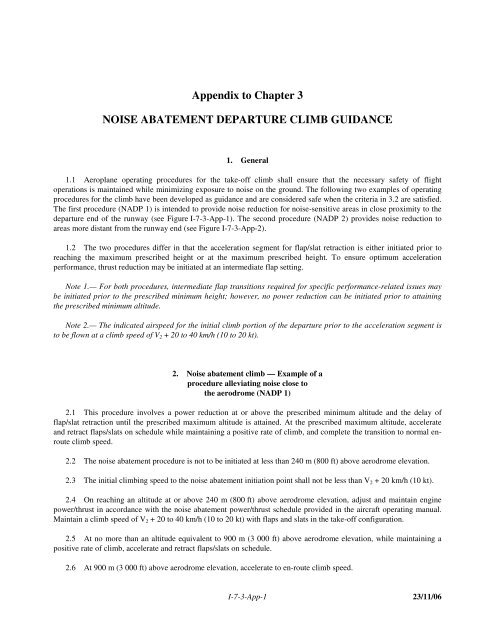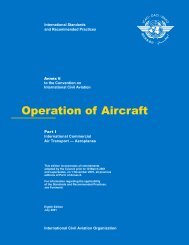Aircraft Operations
Doc 8168 Aircraft Operations, Volume I Flight Procedures
Doc 8168 Aircraft Operations, Volume I Flight Procedures
- No tags were found...
You also want an ePaper? Increase the reach of your titles
YUMPU automatically turns print PDFs into web optimized ePapers that Google loves.
Appendix to Chapter 3<br />
NOISE ABATEMENT DEPARTURE CLIMB GUIDANCE<br />
1. General<br />
1.1 Aeroplane operating procedures for the take-off climb shall ensure that the necessary safety of flight<br />
operations is maintained while minimizing exposure to noise on the ground. The following two examples of operating<br />
procedures for the climb have been developed as guidance and are considered safe when the criteria in 3.2 are satisfied.<br />
The first procedure (NADP 1) is intended to provide noise reduction for noise-sensitive areas in close proximity to the<br />
departure end of the runway (see Figure I-7-3-App-1). The second procedure (NADP 2) provides noise reduction to<br />
areas more distant from the runway end (see Figure I-7-3-App-2).<br />
1.2 The two procedures differ in that the acceleration segment for flap/slat retraction is either initiated prior to<br />
reaching the maximum prescribed height or at the maximum prescribed height. To ensure optimum acceleration<br />
performance, thrust reduction may be initiated at an intermediate flap setting.<br />
Note 1.— For both procedures, intermediate flap transitions required for specific performance-related issues may<br />
be initiated prior to the prescribed minimum height; however, no power reduction can be initiated prior to attaining<br />
the prescribed minimum altitude.<br />
Note 2.— The indicated airspeed for the initial climb portion of the departure prior to the acceleration segment is<br />
to be flown at a climb speed of V 2 + 20 to 40 km/h (10 to 20 kt).<br />
2. Noise abatement climb — Example of a<br />
procedure alleviating noise close to<br />
the aerodrome (NADP 1)<br />
2.1 This procedure involves a power reduction at or above the prescribed minimum altitude and the delay of<br />
flap/slat retraction until the prescribed maximum altitude is attained. At the prescribed maximum altitude, accelerate<br />
and retract flaps/slats on schedule while maintaining a positive rate of climb, and complete the transition to normal enroute<br />
climb speed.<br />
2.2 The noise abatement procedure is not to be initiated at less than 240 m (800 ft) above aerodrome elevation.<br />
2.3 The initial climbing speed to the noise abatement initiation point shall not be less than V 2 + 20 km/h (10 kt).<br />
2.4 On reaching an altitude at or above 240 m (800 ft) above aerodrome elevation, adjust and maintain engine<br />
power/thrust in accordance with the noise abatement power/thrust schedule provided in the aircraft operating manual.<br />
Maintain a climb speed of V 2 + 20 to 40 km/h (10 to 20 kt) with flaps and slats in the take-off configuration.<br />
2.5 At no more than an altitude equivalent to 900 m (3 000 ft) above aerodrome elevation, while maintaining a<br />
positive rate of climb, accelerate and retract flaps/slats on schedule.<br />
2.6 At 900 m (3 000 ft) above aerodrome elevation, accelerate to en-route climb speed.<br />
I-7-3-App-1 23/11/06












